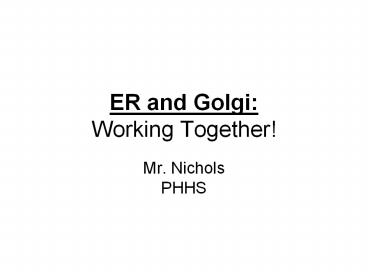ER and Golgi: Working Together! - PowerPoint PPT Presentation
1 / 46
Title: ER and Golgi: Working Together!
1
ER and Golgi Working Together!
- Mr. NicholsPHHS
2
Moving things around- Endoplasmic Reticulum and
Golgi apparatus
- Where were going with this-
- The problem solved by ER and Golgi
- Basic structure of ER and Golgi
- Stories- how things get in, the routing through
the ER to the Golgi, the possible routes, and the
particulars of the lysosome story. - Endocytosis and Phagocytosis
3
- THE PROBLEM Proteins and lipids not only have
to be made, but they also have to end up in the
right location- polymerases in the nucleus,
glycolytic enzymes in the cytoplasm, ATP synthase
in the inner mitochondrial membrane, Na/K pump in
the cell membrane, etc. - The endomembrane system does this- the FedEx
system of the cell.
4
- WHAT- network of channels, tubules, and flattened
sacs that run throughout the cytoplasm. The
interior of the network is the ER lumen, or the
cisternal space. Continuous w/ the perinuclear
space, and connected, via vesicles, to the Golgi,
lysosomes, peroxisomes, and to the outside. It
can constitute over half of the total membrane in
an average cell in your body.
5
(No Transcript)
6
- Types of ER-
- Smooth- no ribosome- makes lipids
- Rough- ribosomes- proteins for transport or
insertion into membranes are first made here. - Basic principles
7
A change in conditions- often pH- results in
releast of the ligand
8
The big picture on sorting- proteins can be in a
lysosome, in a vesicle thats secreted,
membrane-bound and destined for the surface or a
lysosome, etc.
9
Getting things in
http//www.wiley.com/college/fob/quiz/quiz10/10-20
.html
10
http//www.ncbi.nlm.nih.gov/books/bv.fcgi?ridmboc
4.figgrp.2215 http//www.ncbi.nlm.nih.gov/books/bv
.fcgi?ridmboc4.figgrp.2224 http//www.ncbi.nlm.ni
h.gov/books/bv.fcgi?ridmboc4.figgrp.2227 http//w
ww.ncbi.nlm.nih.gov/books/bv.fcgi?ridmboc4.figgrp
.2228
11
All sorts of final destinations Orientation is
maintained
12
(No Transcript)
13
MAKING LIPIDS
- These are mostly made in the ER (mostly smooth
ER) They are made on the cytosolic side, and
then some flipped to the lumenal side by
flippases. There are other mechanisms that
also work to keep the membrane asymmetric . Not
only are the membranes asymmetric (inside vs
outside), but the ER differs from the Golgi which
differs from the cytoplasmic membrane(8.15).
14
(No Transcript)
15
(No Transcript)
16
Glycosylation
- N-Glycosylation occurs in the ER a collection of
14 sugars are added to particular asparagines
residues. Fig. 8.16,17 - Key points the oligo is formed on a dolichol
molecule, and added as a unit. (HINT test Q!) - The first 7 sugars- GlcNac and Man- are added on
cytosol side to dolichol this unit is then
flipped into the lumen side, where the rest are
added. Charged sugars, activated by the addition
of nucleoside diphosphates, are used to make the
oligos. - What does glycosylation do? Good question! One
possible role is that of getting proteins folded
properly-they bind to chaperone proteins, that
help fold the protein properly- Fig 8.18.
17
You cant just add sugars! They have to be
charged!
18
(No Transcript)
19
MOVING THINGS FROM THE ER TO THE GOLGI
- Were going to move things by vesicular
transport, from the ER, through the Golgi and on
out. - Were going to look at Golgi structure, and some
key components to moving things, and what goes on
in the Golgi apparatus - Then we get things out of the Golgi
20
(No Transcript)
21
COP II brings things out
COP I brings things back
(ER-Golgi intermediate compartment)
(Vesicular- tubular carriers)
22
Mostly stays in the ER
23
Handling the escapees-KDEL is the signal I am an
ER protein- bring me back, KDEL receptor!
24
Where can things go from the TGN?
- Secreted- constitutive
- Regulated secretion
- Lysosomes
25
Lysosomes
- Little bags full of acid hydrolases (table 8.1)-
degrade things within them (separate from the
cytoplasm) - Terrible things happen when some of the enzymes
arent there, particularly those that degrade
lipids (Human Perspective) - Getting a lysosomal enzyme into a lysosome-
SIGNALS- - http//www.youtube.com/watch?vekdIEpSf-1I
26
http//www.ncbi.nlm.nih.gov/books/bv.fcgi?ridmboc
4.figgrp.2379
These two enzymes work together, and only add
NAG-P to target proteins with the right signal
patch (see link)
27
Escapee lysosomal enzyme!
28
(No Transcript)
29
Docking allows fusion
Tethering- gets it close
30
(No Transcript)
31
(No Transcript)
32
(No Transcript)
33
Lysosomes and autophagy- we destroy old, worn-out
organelles w/ lysosomes.
34
GETTING LARGE PARTICLES and PROTEINS INTO THE
CELL PHAGOCYTOSIS AND ENDOCYTOSIS
- Bulk-phase endocytosis (pinocytosis)
- Receptor-mediated endocytosis- well look at RME
of low-density lipoprotein
35
(No Transcript)
36
Now well look at the pinching off w/ clathrin a
bit closer
37
(No Transcript)
38
(No Transcript)
39
(No Transcript)
40
Phagocytosis
Phagolysosome
41
http//www.microbelibrary.org/images/tterry/anim/p
hago053.html
http//www.youtube.com/watch?vI_xh-bkiv_cNR1
42
(No Transcript)
43
Bringing things in post-translationally- the TOM
and TIM story
- Proteins for the mitochondria and chloroplast are
made, with signals, and then moved through the
membranes to their proper location. - Transporter for the Outer Membrane- threads
through OM - Transporter for Inner Membrane- threads through
or into IM. - HSP (Heat shock proteins) unfold and refold the
protein on both sides
44
(No Transcript)
45
Key Points
- Stories to tell signal hypothesis
- Getting things from the ER to the Golgi- COP II
and I, KDEL. - Glycosylation- activated sugars, dolichol.
- Getting things into a lysosome- the M6P story
- Vesicle fusion- V-SNARES and T SNARES
46
Key Points (contd)
- Phagocytosis vs endocytosis
- TOM and TIM, roles of HSPs and signals.































